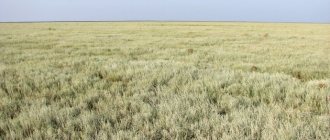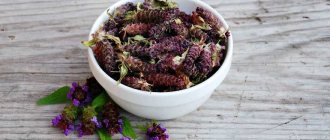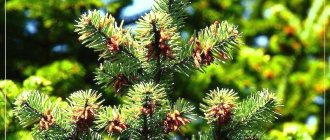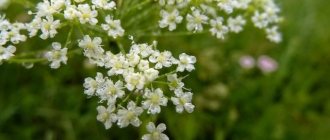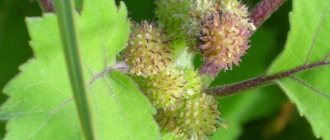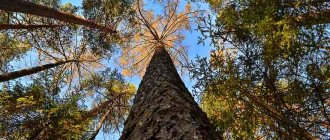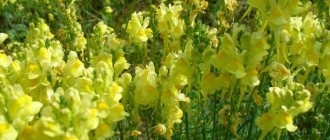Common cress (in many countries the plant is better known as St. Barbara's herb) is a herbaceous biennial that is widely used in folk medicine. Due to its high content of beneficial elements, the herb is often used in the treatment of male and female diseases.
Saturated decoctions and infusions effectively cope with reproductive disorders and diseases of the genitourinary system. Despite the simplicity of using home remedies, it is not recommended to begin treatment without first studying the basic characteristics of the plant, preparation rules, use of herbal medicines, and prohibitions.
Brief description of cress, growth
Common cress is a herbaceous biennial plant that is part of the huge Brassica family. The stem is straight, branched in the upper part. The height of an adult plant is up to 60 cm. The leaves are pinnate (the leaves are petiolate in the lower part).
The flowers are yellow, small, collected in clusters and bloom in June. Flowering ends with the ripening of the fruit - a pod with four sides, each containing small pea seeds.
The plant is distributed throughout the world and prefers temperate climates. In Russia it is found throughout the European part; thickets of cress can also be found in Western Siberia. Usually it prefers soils saturated with moisture - the banks of reservoirs, swampy areas, although it feels comfortable on the side of roads, meadows, and fields.
Description of the plant and place of growth
Crescent is a taproot perennial that belongs to the Cruciferous family. In some regions this plant is called wildflower. In European countries, another name is common - St. Barbara's grass. This great martyr is considered a protector from wounds and violent death.
Rapeseed rape grows in Europe, incl. in the European part of Russia and Western Siberia. It was introduced to North America, Japan, Africa, Australia and New Zealand. The plant's unpretentiousness allows it to survive in different climates and soil characteristics, but it grows best in moist soils, in forest areas, meadows and fallow fields.
The height of the grass is 30-80 cm. The stem can be straight or curved, with a smooth or slightly fluffy surface. The lower leaves are lyre-shaped with a fleshy core, and the upper leaves are ovate. The inflorescences are dense brushes with bright yellow buds.
Crescent blooms from May to June . In southern regions, buds may appear 2-3 weeks earlier. If the grass grows near the apiary, then the bees actively sit on the flowers, collecting pollen and nectar.
After the end of the flowering period, the rapeseed bears fruit in small oblong pods containing seeds. At the end of the biological cycle, the upper part of the plant dies.
Crescent grass is used in the following areas:
- traditional medicine;
- agriculture (as a green manure plant);
- beekeeping;
- cooking;
- light industry, leather dressing, soap making (as a source of oil).
In terms of origin and technical significance, rapeseed is similar to another honey plant - rapeseed. It also belongs to the Cruciferous family, but is not a weed and can be used as a forage crop.
Rules for collection, drying, storage
For treatment, only the greens of the plant are used (leaves along with stems and flowers). It is recommended to stock up on medicinal plant materials during the period of active growth and flowering (from April to July). Ripening of seeds causes a decrease in medicinal properties; you should not collect the grass at this time.
Cut off the above-ground part with a sharp knife, leaving small stumps (up to 15 cm). At home, rinse the plant material with running water and chop into small pieces. Dry the colza on baking sheets or racks covered with gauze.
Avoid exposure to direct sunlight; it is better to dry under shelters, ensuring good ventilation. In cool, rainy weather, it is recommended to use an oven (optimal temperature is 35-40 degrees).
Send ready-to-use plant particles into cardboard boxes, glass jars, and plastic containers. Do not use plastic bags for storing raw materials - the healing component of homemade medicines will quickly begin to rot and deteriorate. Properly dried rapeseed does not lose its medicinal qualities for two years.
Article for you:
Medicinal properties of cocklebur and its use in folk medicine
The plant is recognized as official medicine - you can buy dry herb at pharmacies. The cost of packaging (25 grams) is 40-45 rubles. Plant-based preparations are not produced - you will have to prepare the products yourself.
Components of colza and its healing properties
In herbal medicine, the above-ground part of the plant is used: flowers, leaves, and stems. The most valuable substances contained in colza are:
- flavonoids;
- vitamins C, B;
- cellulose;
- essential oils;
- organic acids.
Crescent has a tonic and diuretic effect. Successfully used to treat a number of diseases:
- stroke;
- epilepsy, paralysis;
- urinary tract diseases;
- neurasthenia and asthenic syndrome;
- avitaminosis;
- prostatitis;
- impotence;
- BPH;
- male infertility.
The juice of the plant is also used to treat small scratches on the skin in order to stimulate their rapid healing. In addition, rapeseed restores water balance in the body and normalizes cholesterol levels in the blood.
Thanks to the use of cress, you can not only get rid of the above diseases or reduce the severity of their symptoms, but also strengthen the body, saturate it with necessary vitamins and microelements.
Treatment of prostatitis, impotence with colza tincture
Traditional medicine recommends that men with decreased sexual function, problems with the reproductive system, impotence, and inflammation of the prostate use a rich tincture of colza. The product relieves inflammation, facilitates urination, eliminates pain, restores male strength, and increases libido.
It is allowed to influence the problem in a comprehensive manner - traditional treatment, drug therapy prescribed by a specialist. Step-by-step folk recipe:
- Finely chop fresh vegetable raw materials (100 grams) and mash them a little with your hands.
- After the juice appears, send the green mass into a glass bottle.
- Pour in pervach or vodka (500 ml), stir.
- Seal tightly and place in a cool room to infuse.
- The product is prepared for three weeks; during this period, shake the bottle regularly.
- Strain and store refrigerated.
Use three times a day. Dosage – 15 ml. In case of a serious problem, it is allowed to increase the amount of the product - take 20 ml. In case of increased sensitivity of the body, dilute with water. It has been noted that the most effective would be to take before a meal - the active components begin to immediately affect the problem.
Crescent: description and useful properties
Pea is considered a weed. It is difficult to get rid of; it is resistant to various herbicides. Common cress grows in many countries of the world; it is recognized as a cosmopolitan plant.
The grass begins to bloom in late spring or early summer. The common rapeseed bears fruit only from the 2nd year of vegetative development. This plant can be distinguished from other species by its smooth, highly branched stem, which reaches a height of 35-80 cm. Lyre-shaped leaves grow in its lower part, and at the top they become oval, with denticles visible at the edges.
The flowers of the rape plant are yellow and are found at the top of the bush. Each flower has 4 petals, they reach 0.4-0.8 cm in length. Each flower has 5 stamens inside. When compiling a flower formula, it is taken into account that the petals are arranged crosswise, the flowers are regular, framed by a double perianth.
Flowering ends with the formation of fruits that look like rounded tetrahedral pods. Inside them are oval, almost flat seeds. After the fruiting period ends, the above-ground parts die off, leaving only the root.
photo of a flowering plant in its natural habitat
The colza grass reproduces by seeds and root shoots. The root part of the plant is well developed; it can grow up to 100 m in different directions. The roots of different bushes intertwine in the soil with each other, forming a large network.
All parts of the plant are used for medicinal purposes. Both seeds, flowers, leaves and roots are useful.
Characteristics. Where does it grow?
The plant is distributed on many continents. It is found in Europe, Russia (in its European part and Western Siberia). The perennial was brought to Africa, North America, New Zealand, Japan, and Australia.
Spring rape is not picky. It can be found in forests, fields, meadows, in crops of perennial grasses, near water bodies and in roadside areas. But this plant prefers the forest zone; in the southern regions it can only be found in places with high humidity.
When planning to collect medicinal leaves and flowers, you need to remember that cress is a weed. Therefore, you can find grass in forest clearings, in ditches, in places where garbage accumulates, and in bushes.
despite the fact that the plant is a harmful weed, it has medicinal qualities and is used for medicinal purposes
It infests crops of winter crops, perennial grasses, vegetable gardens, and orchards, so agronomists are always trying to find the most effective measures to combat this plant. Low mowing of the weed during the flowering period, shallow plowing in the autumn and pre-sowing cultivation and harrowing help. At the beginning of flowering, the plant is sensitive to herbicides, then it becomes more difficult to get rid of it.
What are the benefits of seeds, leaves, flowers and roots
Supporters of traditional medicine recommend harvesting rapeseed flowers during the flowering period. They include:
- B vitamins;
- vitamin C;
- flavonoids;
- glycosides.
They have a positive effect on the functioning of the nervous system, normalize the functioning of the kidneys and heart and improve the condition of blood vessels. Vitamin C helps strengthen the immune system and takes part in the process of growth and renewal of body cells.
The leaves contain organic acids necessary for the body, including ascorbic acid. They are needed to maintain acid-base balance. They also contain vitamins and other beneficial substances. The juice obtained from the leaves is characterized by antiseptic and wound-healing properties.
All parts of the plant have medicinal value - flowers, leaves, roots and seeds
Crescent seeds are rich in thioglycosides. These substances have an antimicrobial effect, but when they enter the body they irritate the gastric mucosa. Under their influence, gastric juice begins to be produced and a feeling of hunger appears. Due to this property, pea seeds are used to increase appetite.
From the seeds you can obtain rapeseed oil, which is used industrially in baking bread and producing various bakery products. Baked goods containing butternut squash seed oil are recommended for patients with identified vitamin C deficiency, asthenic syndrome, and pathology of the nervous system. The development of these diseases can be suspected by constant fatigue, insomnia, and increased excitability.
The root system of rapeseed is also useful. The roots contain diuretic flavonoids; when consumed in the form of decoctions or infusions, a pronounced diuretic effect is observed. The underground part of the plant contains biological substances that have an antiseptic effect. They help the body get rid of bacteria, germs and other pathogens.
Decoctions are made from the roots, the use of which is indicated for infertility, prostatitis and other diseases of the genitourinary system.
the herb has medicinal properties, but also has contraindications for use
Crescent decoction for infertility (men, women)
Crescent is a herb containing elements that actively affect the reproductive function of the body. Alternative medicine recommends taking a saturated decoction for male and female infertility. In drug therapy, herbal medicine will serve as an effective adjuvant. Step by step recipe:
- Break dry vegetable raw materials (10 grams) into small pieces.
- Boil water (200 ml) and steam the herbal mixture.
- Leave for 5 minutes, bring to a boil, immediately remove and leave to infuse.
- Strain after half an hour.
Take the prepared decoction twice a day, 80-100 ml. Adding additional ingredients that improve taste (sugar, honey) is prohibited - there is a risk of reducing the beneficial properties. Treatment at home is carried out in courses - a month of admission, a two-week break.
The use of rapeseed in folk medicine
Common colza is often found in home health recipes. The plant is used for slagging in the body, for reproductive disorders, for nervous disorders and inflammatory processes.
How to drink a decoction of colza for epilepsy
Common cress has a beneficial effect on the body in neurological disorders and reduces the frequency of seizures in epilepsy. For treatment, prepare the following decoction:
- Four large spoons of dried leaves are poured into 1 liter of hot water.
- Heat for half an hour over low heat.
- Strain the finished product and add clean liquid to the initial volume.
- Leave covered for another eight hours.
You need to consume the decoction for two weeks, 50 ml shortly before meals. The daily dosage should be at least 200 ml.
For fibroids
The medicinal herb cress evens out hormonal levels in women and prevents the growth of tumors in the uterus. For fibroids, the following remedy is prepared:
- Heat 1 liter of water in an enamel pan.
- Pour two large spoons of dried herbs into boiling water.
- Heat the healing solution over low heat for 20 minutes.
- The finished product is infused for two hours under the lid and filtered.
You need to take 25 ml of the decoction four times a day. The course of treatment for fibroids, in consultation with the doctor, is continued for up to three months.
For the kidneys
For urinary retention and pain in the kidneys and bladder, you can use an aqueous infusion of common colza. It is made according to this recipe:
- 20 g of leaves and stems of the plant are crushed and poured with 200 ml of boiling water.
- Close the container with a tight lid and leave for two hours at room temperature.
- The cooled product is passed through gauze.
You need to drink the infusion 25 ml three times a day.
Common cress relieves inflammation and removes fine sand from the kidneys
For infertility in men
You can use the valuable properties of the plant not only for problems with potency, but also for difficulties with conception. One of the recipes for colza for men looks like this:
- 10 g of dried herbs are mixed with an equal amount of parsley and carrot grains.
- Add 10 g of chopped plantain, coriander and black onion seeds.
- Mix the components and pour in 500 ml of hot liquid.
- Boil over low heat for half an hour.
- Remove from the stove and leave covered for eight hours.
The finished broth is filtered and consumed half a glass in the morning and evening shortly before bedtime.
For swelling
If there is fluid retention in the body and severe swelling, you can prepare the following infusion:
- 40 g of dry leaves and stems of the plant are poured with 400 ml of hot water.
- Leave covered for three hours.
- Pass the infusion through folded gauze.
We recommend reading: What does aspen bark help with, beneficial properties and contraindications
When warm, the product is taken 50 ml up to four times a day.
For adenoma
The anti-inflammatory properties of common colza improve the condition of adenoma in men. The following remedy is prepared for therapy:
- 5 g of dry plant seeds are ground into powder.
- Pour the raw material into a glass of water and bring to a boil on the stove.
- Simmer over low heat for seven minutes.
- Remove from heat and leave covered for an hour.
The strained product is consumed twice a day, 120 ml on an empty stomach.
A decoction of cress for adenoma prevents the disease from becoming malignant.
For liver diseases
Common colza removes toxins well and helps reduce the load on the liver. To cleanse the body and restore the organ, use the following collection:
- 5 g of dried colza leaves are mixed with a similar amount of nettle, St. John's wort and plantain.
- Add 5 g of medicinal sage.
- Grind the plant mass and pour in 300 ml of boiling water.
- Leave covered to infuse for half an hour.
The finished drink needs to be filtered. Take the collection 120 ml three times a day on an empty stomach. To properly cleanse the body, you need to continue using the product for at least three weeks.
Advice! It is recommended to use colza to remove toxins once every six months. This will keep your liver healthy at all times.
For vitamin deficiency
You can use ordinary colza if you have a lack of vitamins and a loss of strength. For therapy purposes, prepare a simple water infusion:
- Pour 40 g of dried herb into 200 ml of liquid.
- Keep covered for three hours.
- Filter before use.
Take 50 ml of the product four times a day on a full stomach.
Infusion of the plant for cystitis
Cystitis is the most common female disease. Crescent is a herb that can eliminate the main signs of the disease. The treatment will help you cope with painful sensations in the lower abdomen, regulate the emission of urine, and relieve discomfort in the genitals.
Article for you:
White cinquefoil - beneficial properties and contraindications
Homemade medicine will be of particular benefit for chronic cystitis - it will protect the female body from relapses and normalize the functioning of the genitourinary system. Preparation:
- Place dry or fresh plant material (a teaspoon) in a thermos.
- Steam the herb with boiled water (220 ml).
- Close the thermos tightly, leave for an hour, strain.
Use the product in small (20 ml) portions every three hours. It is advisable to take it after a meal. Treatment does not have to be long - just two weeks is usually enough to eliminate all symptoms of the disease. If the signs of cystitis do not go away, stop taking it, consult a doctor, and find out the reason for the lack of results.
It is recommended to be careful when treating cystitis with colza infusion - the herb has a strong diuretic effect. You should not take the product just before going to bed; the last use of the composition should occur 2 hours before bedtime.
Methods of preparation and use
Traditional medicine uses the leaves, flowers and shoots of colza for medicinal purposes. On their basis, alcoholic and aqueous preparations with strong healing properties are prepared.
Tincture
A strong tincture of common colza helps with infertility in men, as well as with inflammatory processes in the reproductive sphere. The product is made according to this recipe:
- 30 g of herbs are crushed and poured with 500 ml of good vodka;
- shake the closed vessel and put it in a dark place for two weeks;
- After some time, filter through cheesecloth.
We recommend reading: Panzerina (panzeria) woolly: medicinal properties, applications, reviews
You need to take 15 ml of the tincture three times a day on an empty stomach.
It is recommended to be treated with tincture of colza herb for no longer than two weeks in a row.
Infusion, decoction, tea
The medicinal properties of the herb colza for men are manifested when consuming an infusion of the plant. It is prepared according to this recipe:
- Dry leaves of the plant are crushed in the volume of a large spoon.
- Pour the raw material into 250 ml of boiling water in a thermos.
- Close the vessel tightly and leave to infuse for three hours.
- When ready, filter.
It is useful to use the drug for prostatitis - drink the drug two large spoons four times a day on an empty stomach. The course of treatment should be two months.
If you have high blood pressure and a weakened immune system, you can brew tea from cress greens. Traditional medicine offers the following recipe:
- 30 g of dry leaves and stems are poured with 300 ml of boiling water.
- Place on the lowest heat and heat for ten minutes.
- Remove from the stove and leave covered for another half hour.
Strained colza tea is consumed like regular tea, about 250 ml each. But you should take no more than two cups of this healthy drink per day.
For mastopathy in women, a decoction of common colza is recommended for preparation. Necessary:
- Steam 1 liter of boiling water with 30 g of dried leaves and stems.
- Place the solution on low heat for 25 minutes.
- Leave the resulting product covered for two hours.
- Strain off the sediment.
Take a decoction of 60 ml up to four times a day. In total, treatment can be continued for three months.
Decoctions and infusions of colza can be used to wipe the skin for irritation and damage.
Treatment of nervous disorders, vascular diseases, heart diseases with a decoction of flowers
Crescent flowers contain a unique combination of beneficial elements that have a beneficial effect on the heart, vascular and nervous systems. Homemade medicine, prepared from valuable plant materials, normalizes heart function, reduces the risk of serious diseases (stroke, heart attack), strengthens the walls of blood vessels, increases elasticity, and improves blood composition.
For frequent nervous disorders and stress, you also cannot do without the use of herbal medicine - the active components strengthen the nerve system, improve sleep, and cope with insomnia caused by stress.
Steam a teaspoon of fresh plant flowers with boiling water (150 ml). Place on the stove, after boiling, remove, wrap in a towel, and leave for a quarter of an hour. Strain and divide into two parts. Drink one in the morning, the second in the afternoon.
Do not take it in the evening - like green grass, flowers have a diuretic effect. Use the product daily for a week. If necessary, take another course after the break (after 3-5 days).
Description
Common cress is a taproot plant. Its height is usually 30 – 80 centimeters. The stem is highly branched and can be either bare or slightly fluffy. Stem and basal leaves are located on petioles, may have two or three oblong lateral lobes, and the lobe located at the base is heart-shaped, notched-toothed. The cress has a brush-shaped inflorescence, which is initially unbranched. And its flowers are four-membered, have a double perianth, and are golden-yellow in color. The length of the petals is 5-7 mm. Each flower has as many as five stamens.
The fruit is an oblong pod with a short club-shaped nose. Its valves are straw-yellow in color. The stalks are quite short. Crescent seeds are oval in shape, brownish-gray in color, and have a slight shine. From above they seem to be finely tuberculate.
Cleansing the body with herbal tea
Another feature of rapeseed is the removal of harmful substances from the body. The herb copes with waste, toxins, protects organ tissue, improves the functioning of all systems. Herbal raw materials work most effectively in combination with other herbal components. Preparation:
- Combine 5 g. leaves of cress, plantain, nettle, sage, St. John's wort.
- Finely chop the plant mass and steam with boiling water (280 ml).
- Leave for half an hour, strain.
Take twice a day. Dosage – 120 ml. Be sure to use the composition before meals (half an hour before). Cleaning is carried out in courses; you need to drink herbal medicine for at least three weeks. Cleanse the body of harmful elements every six months.
Article for you:
Medicinal properties of alfalfa and its use in folk medicine
Recipes for decoctions and infusions
Decoctions and infusions are prepared from various parts of the bush. Before preparing any medicinal product, the colza must be thoroughly washed and dried .
- Tincture for getting rid of swelling, treating epilepsy and neurotic disorders. Place four tablespoons of dried leaves in one liter of boiling water and leave to simmer over low heat for 30 minutes. Afterwards, decant the mixture and let it brew for 8 hours. The treatment time is 2 weeks, you need to use the product half an hour before meals, 50 ml. You need to drink 200 ml of decoction per day.
- Tincture for the treatment of fibroids and mastopathy, as well as normalization of hormonal levels. To make the tincture, you need to put 2 tablespoons of dried leaves in one liter of boiling water and leave to boil for another half hour, first reducing the heat to a minimum. Then pour this composition into a hermetically sealed container and let it brew for two hours. The treatment time with the tincture is three months, it must be consumed up to 4 times daily at a time of 50 ml.
- Tea that improves vitality and lowers blood pressure. In 350 ml of boiling water you need to put two tablespoons of dried herb raw materials (you can use both stems and leaves). After 10 minutes of boiling, the composition must be allowed to brew for another half hour. Tea can be consumed in a glass, no more than 3 times a day.
- Tincture for relieving painful sensations when urinating. In 250 ml of boiling water you need to put 25 grams. herbs (stems and leaves), then turn off the heat and pour this mixture into a hermetically sealed container. After 2 hours, the composition can be consumed in 50 ml, no more than 3 times a day after each main meal.
- Juice against spermatogenesis disorders and for the treatment of prostatitis. Mix flowers, grass, stems, and bush seeds in a blender or grind with a meat grinder, then squeeze the juice out of the resulting mixture. You need to consume it 150 ml daily, dividing this volume by 3 times. You should take the juice after meals. Treatment time is 2 weeks.
- Recipe for the treatment of male impotence. The total treatment time is 3 weeks. You need to grind the dried roots into powder and consume 0.5 grams of it. twice a week with plenty of water. A positive result can be observed after the first course of treatment.
Indications
In common parlance, the common cress is considered a male plant, since its healing properties are of interest to the stronger sex.
Tinctures and decoctions of colza promote faster recovery after strokes or heart attacks, help solve the problem of frequent constipation and colds, and support the immune system and nervous system.
Crescent improves blood circulation in the pelvic organs, and therefore has a beneficial effect on potency.
Many experts are of the opinion that this, unremarkable at first glance, plant helps to get rid of not only sexual disorders, but also helps to improve the composition of seminal fluid.
The juice from the stems and leaves helps speed up the restoration of the skin, for this reason it is often used to treat wounds, small abrasions and scratches. Crescent will be an excellent remedy for reducing the amount of cholesterol in the body and normalizing water balance.
Unfortunately, not all representatives of the stronger sex consult a urologist in a timely manner, even if they notice clinical manifestations of prostatitis. For such frivolity they can pay with a prostate tumor, problems with potency, infertility and even kidney failure.
If you start treating the disease in time, you can get rid of it in the near future. The use of rapeseed in the treatment of prostatitis is one of the most effective and harmless means on the path to a cure.
